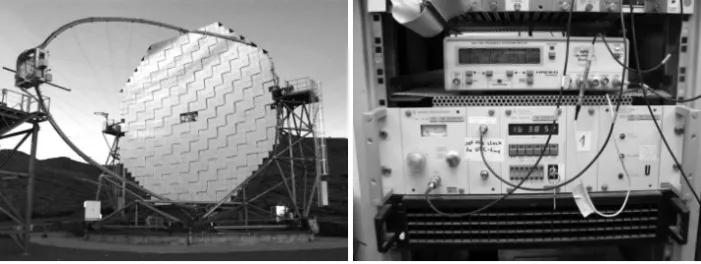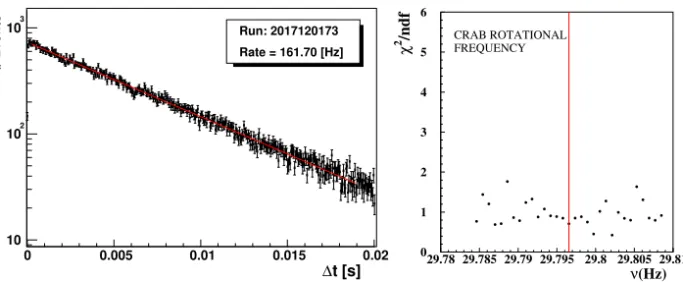December 1, 2005 14:36 WSPC/Guidelines-IJMPA 03071
International Journal of Modern Physics A Vol. 20, No. 29 (2005) 7012–7015
c
World Scientific Publishing Company
THE TIMING SYSTEM OF THE MAGIC TELESCOPE
F. LUCARELLI, M. L ´OPEZ, E. O ˜NA-WILHELMI, M. V. FONSECA (for the MAGIC COLLABORATION)
and H. G. B ¨ORST
Dpto. Fis. Atomica, Fac. Ciencias Fisicas, Universidad Complutense, Madrid, 28040 Spain
Universit¨at Kiel, Inst. f¨ur Experimentelle und Angewandte Physik, Leibnizstrasse 15-19, Kiel, D-24118 Germany Received 22 October 2004
The Major Atmospheric Gamma-ray Imaging ˇCerenkov Telescope (MAGIC) will be the first ground- based ˇCerenkov telescope able to detect photons with E>30 GeV. This region of the electromagnetic spectrum, yet unexplored, is fundamental for pulsar physics since theoretical models foreseen a cut-off in the pulsed emission at tens of GeV. In order to perform timing analysis of pulsars, accuracy below milliseconds in the time stamp of the detected event is needed. In this work, we present the timing system of the MAGIC telescope and the first timing analysis performed on real data.
Keywords:γ-ray astronomy; pulsars; ˇCerenkov technique.
1. The MAGIC telescope
The MAGIC telescope
1(Fig. 1) is a newly developed and innovative instrument dedicated to the detection of high and very high energy γ -rays (E > 30 GeV) from astrophysical sources. The telescope is located at the “Roque de los Muchachos” Observatory, on the Canary Island of La Palma (Spain), and makes use of the well established Imaging Atmo- spheric ˇCerenkov Technique (IACT).
2Its major characteristics are:
• a 17 m diameter tessellated mirror mounted on an extremely light frame ( <
10 tons);
• main detector composed by an array of 577 fast photomultipliers placed at the main focus of the telescope (overall field of view: ∼ 4
◦);
• analogue signal transmission through optical fiber and signal digitization per- formed by 300 MHz FlashADCs.
MAGIC huge collection area (∼ 254 m
2) along with the use of advanced technol- ogy for digitization and signal transmission will allow to reduce the energy threshold of a ground-based detector down to 30 GeV. Thus, MAGIC will be the first experiment to explore the yet unobserved observation window of the electromagnetic spectrum between 30 to 300 GeV. These observations will provide vital information on several established γ -ray sources, like Active Galactic Nuclei, Supernova Remnants, Gamma Ray Bursts and Pulsars. MAGIC has started data taking during commissioning phase in November 2003.
7012
December 1, 2005 14:36 WSPC/Guidelines-IJMPA 03071
The Timing System of the MAGIC Telescope 7013
Fig. 1. Left Panel: the MAGIC telescope in July 2004.Right Panel: the atomic clock and on top the GPS Time/Frequency standard.
2. Search for pulsars at GeV energies
Pulsars are rapidly rotating neutron stars, with periods between a few milliseconds and a few seconds, originated from a supernova explosion. The star co-rotating magnetosphere generates strong electric fields which are able to extract electrons or positrons from the star surface. The radius where the magnetic field lines rotate at the speed of light sets the light cylinder: beyond that, the field lines are opened and starts the pulsar wind region.
The observed pulsed emission from radio to the GeV energy range originates from non- thermal processes which can take place either in regions near the magnetic poles, polar cap models,
3or in vacuum gaps near the light cylinder, outer gap models.
43. The timing system of the MAGIC telescope
In order to perform search for γ -ray pulsed emission from pulsars, the arrival time of an interesting event has to be known with a precision below milliseconds. In the MAGIC telescope the measure of the absolute time is provided by a high-precision atomic clock (Rubclock), formed by a Rubidium standard frequency oscillator in conjunction with a digital clock counter (Fig. 1), which counts the time intervals generated by the frequency oscillator. As the atomic clock shows an unavoidable course error, it has been decided to interlace it with a GPS Time/Frequency standard,
5which is controlling the Rubidium oscillator in frequency and phase. Due to this, the local time is strongly fixed to UTC. The Rub-GPS system allows to reach a time accuracy down to 0 . 2 micro-sec, thanks to the 5 MHz frequency oscillator of the atomic clock, which is largely enough for our purpose.
The Rubclock provides directly time info only up to the units of seconds (super-sec info). In order to get the sub-second information, a dedicated Time Interval Counter (TIC) module had to be built. The TIC module counts the number of 5MHz cycles from the beginning of the second and stops when a trigger has been sent from the central data acquisition (DAQ).
Super-sec and sub-sec info of an interesting event detected by the telescope are fed into the
DAQ and stored together with all the info relevant for the off-line event analysis (Fig. 2).
December 1, 2005 14:36 WSPC/Guidelines-IJMPA 03071
7014 F. Lucarelli et al.
∆t [s]
0.005 0.01 0.015 0.02
100 102
103 Run: 2017120173
Rate = 161.70 [Hz]
# Events
0 1 2 3 4 5 6
29.78 29.785 29.79 29.795 29.8 29.805 29.81 ν(Hz) χ2 /ndf
FREQUENCY CRAB ROTATIONAL
Fig. 2. Left Panel: the difference in time between one event and the next one, calculated using the time stamp provided by the Rub-GPS timing system. Slope of the curve gives the event rate.Right Panel: statistical test for periodicity search around the Crab rotational frequency.
4. First timing studies: the Crab pulsar
MAGIC has extensively observed the Crab pulsar (T = 33 . 56 msec) since October 2003 for calibration studies. However, the full timing info is available only starting from February 2004. We report here the search for pulsation from the Crab for a total amount of 1 . 37 hours taken in March 2004, during the commissioning phase. In this period, the energy threshold of the detector was around 150 GeV. The data sample consists in a total of 630000 events.
The arrival times t
ifor each of these events have to be transformed to an inertial reference frame (the solar barycentre system). For this transformation, the TEMPO software
6has been used.
The corrected times must be folded with the correspondent radio ephemerides (fre- quency, first frequency derivative and reference time) provided by the Jodrell Bank obser- vatory to get the phase Φ
iby a Taylor expansion. A phaseogram was produced for each independent frequency confined in the range between 26 . 0 and 32 . 0 Hz. The folded inten- sities for each test frequency were tested against a uniform distribution by performing a χ
2fit to a constant intensity (Fig. 2). No hint of periodicity was found.
5. Conclusions
The timing system of the MAGIC telescope allows to get an accuracy of 0 . 2 micro-sec. The first timing analysis on a very limited sample of data from the Crab pulsar has shown no hints of periodicity at an energy threshold of 150 GeV. At this energy, no pulsed emission is expected according to the theoretical models.
7Due to the limited data sample, no upper limit was calculated.
References
1. E. Lorenz, “The MAGIC Telescope, status and future plans,” in Proc. of the 3rd International Symposium on High-Energy Gamma-Ray Astronomy, 26–30 July 2004, Heidelberg, Germany;
AIP Conf. Proc.
745, 622 (2005).December 1, 2005 14:36 WSPC/Guidelines-IJMPA 03071
The Timing System of the MAGIC Telescope 7015

